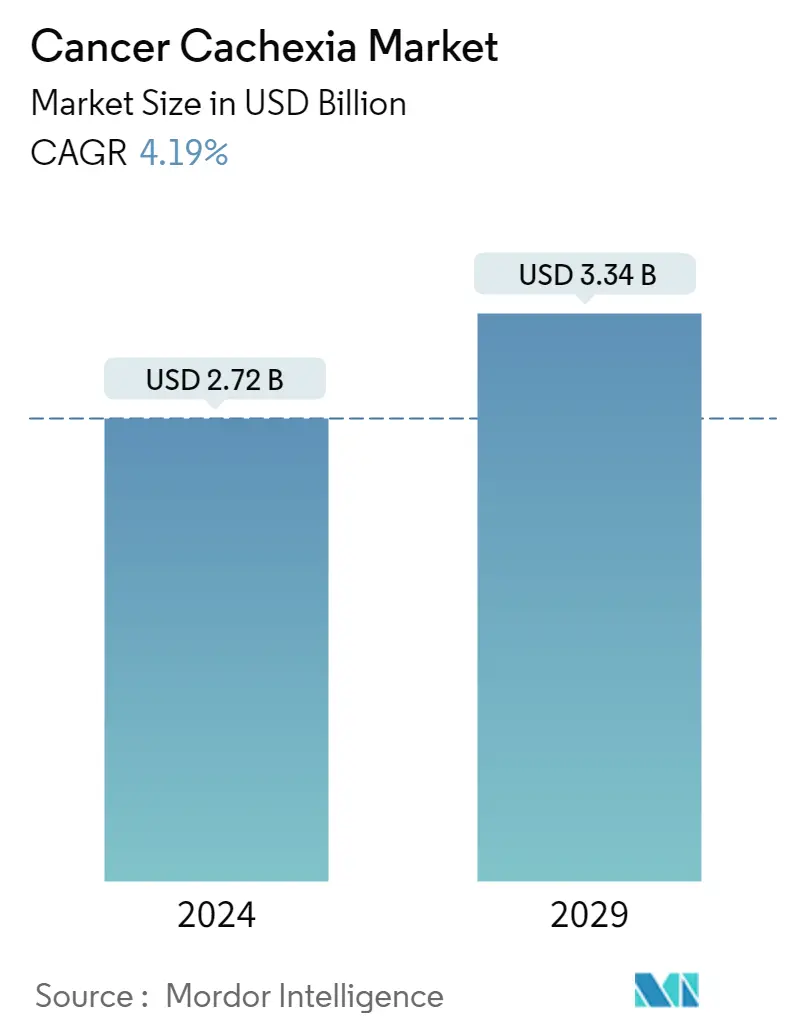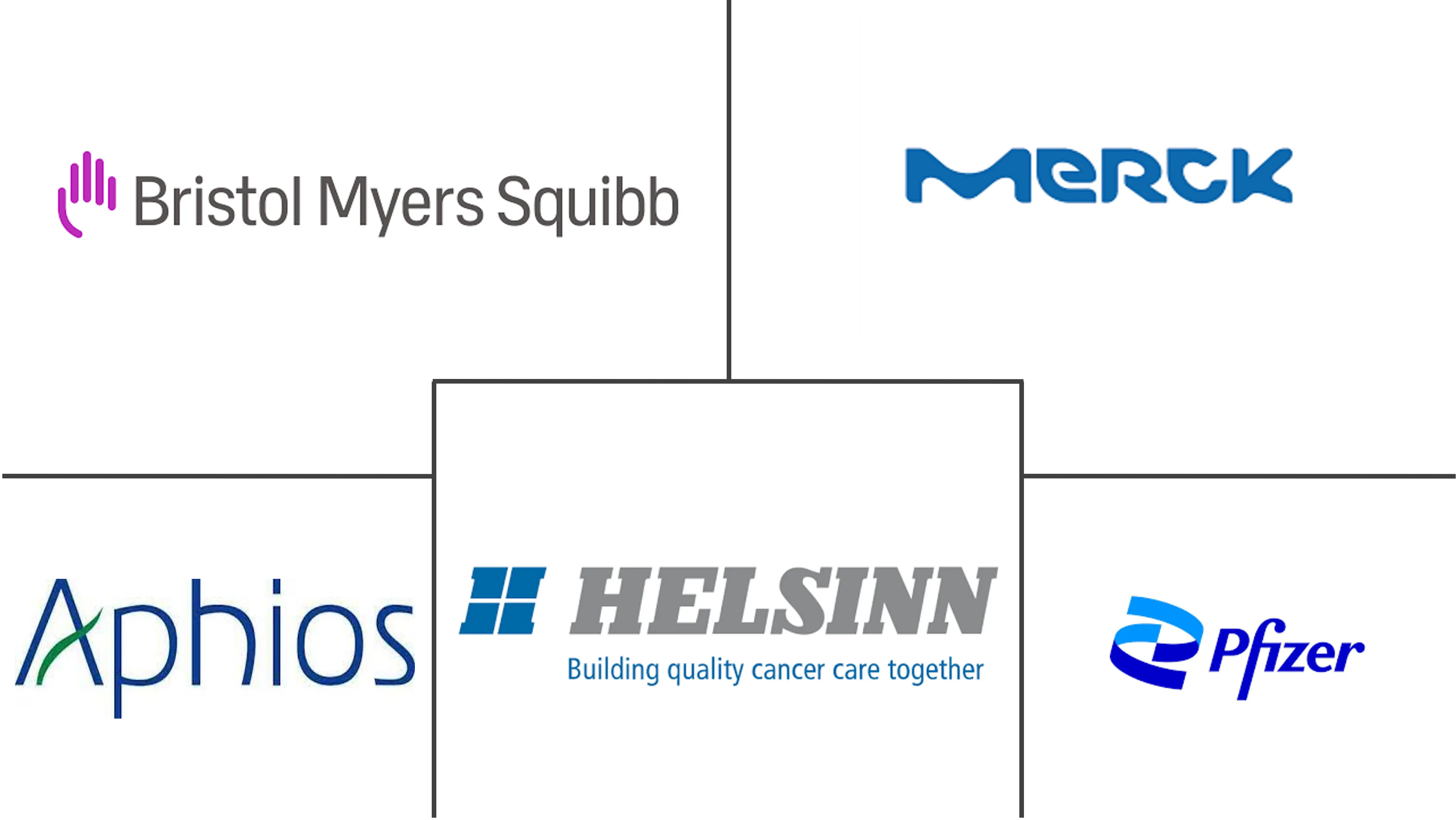Market Size of Cancer Cachexia Industry

| Study Period | 2019 - 2029 |
| Market Size (2024) | USD 2.72 Billion |
| Market Size (2029) | USD 3.34 Billion |
| CAGR (2024 - 2029) | 4.19 % |
| Fastest Growing Market | Asia Pacific |
| Largest Market | North America |
Major Players
*Disclaimer: Major Players sorted in no particular order |
Cancer Cachexia Market Analysis
The Cancer Cachexia Market size is estimated at USD 2.72 billion in 2024, and is expected to reach USD 3.34 billion by 2029, growing at a CAGR of 4.19% during the forecast period (2024-2029).
The COVID-19 outbreak impacted the cancer cachexia market, as hospitals and healthcare services were significantly reduced due to social distancing measures enforced globally. The COVID-19 pandemic also affected the global economy and impacted general hospital care for non-COVID-19 patients in hospitals worldwide. According to a research article published in the British Journal of Nutrition, 2020, changes in nutritional status and weight loss during hospitalization are largely reported in some populations. However, it was not completely explored in COVID-19 patients. During the pandemic, the symptoms and associated conditions of COVID-19 deteriorated nutritional status, leading to cachexia. Cancer patients were at a higher risk of being infected with COVID-19, as they are immunocompromised, and their ability to fight against the infection was very low compared to other individuals. Additionally, if a cancer patient developed a COVID-19 infection, there were higher chances of developing multiple organ-related complications or cachexia. Hence, the COVID-19 pandemic affected the market significantly in it's preliminary phase, however currently the market is expected to have a favorable growth in the forecast period as the COVID-19 has subsided.
The increasing prevalence of cancer and cancer cachexia cases and the increasing investment in the R&D activities for developing novel therapeutics in the treatment of cancer cachexia are the major factors driving the market.
The global cancer burden is increasing. Thus, cancer therapies must be modified according to regional and national priorities. According to the International Agency for Research on Cancer (IARC) in December 2020, globally, 1 in 5 people develop cancer during their lifetime, and 1 in 8 men and 1 in 11 women die from the disease. According to the data published by WHO in February 2022, approximately 400,000 children develop cancer every year and the most common cancers vary between countries. Cervical cancer is the most common in 23 countries. Hence, the increasing burden of cancers worldwide also increases the prevalence of cancer cachexia among cancer patients, which is characterized by systemic inflammation, negative protein and energy balance, and an involuntary loss of lean body mass.
Due to this factor, most of the major players are focused on R&D activities to develop highly effective novel drugs in the treatment of cancer cachexia. This factor resulted in an increased pipeline of therapeutics waiting for approval and commercial launch post-approval. For instance, clinicaltrials.gov reported that, as of October 2022, a total of 150 studies were conducted or were being conducted to develop drugs that treat cancer cachexia. In December 2020, a clinical study was initiated by University of Copenhagen, in collaboration with Zealand University Hospital, the study was conducted to monitor the effect of medical cannabidiol on lean body mass (cachexia) in patients receiving Oxaliplatin- or Paclitaxel-based chemotherapy. Moreover, in January 2021, Helsinn Group and Ono Pharmaceutical Co. Ltd received the manufacturing and marketing approval of Adlumiz in Japan. It is a ghrelin receptor agonist to treat cancer cachexia in malignant tumors of non-small cell lung cancer, gastric cancer, pancreatic cancer, or colorectal cancer.Hence, the increasing research and development activities for cancer cachexia is expected to drive the growth of the market.
However, manufacturers of cancer cachexia drugs are discouraged from investing in the market because of the strict regulatory requirements and the long FDA approval procedure, which may impede the long-term growth of this market.
Cancer Cachexia Industry Segmentation
As per the scope of the report, cancer cachexia is a wasting syndrome characterized by weight loss, anorexia, asthenia, and anemia. The pathogenicity of this syndrome is multifactorial due to a complex interaction of tumor and host factors. The signs and symptoms of cachexia are considered as the prognostic parameters in cancer patients. Cancer cachexia drugs are used to treat or alleviate the condition. The cancer cachexia market is segmented by therapeutics (progestogen, corticosteroid, combination therapy, and other therapeutics), mechanism of action (appetite stimulators and weight loss stabilizers), and geography (North America, Europe, Asia-Pacific, Middle-East and Africa, and South America). The market report also covers the estimated market sizes and trends for 17 countries across major regions globally. The report offers the value (in USD million) for the above segments.
| By Therapeutics | |
| Progestogens | |
| Corticosteroids | |
| Combination Therapy | |
| Other Therapeutics |
| By Mechanism of Action | |
| Appetite Stimulators | |
| Weight Loss Stabilizers |
| By Geography | ||||||||
| ||||||||
| ||||||||
| ||||||||
| ||||||||
|
Cancer Cachexia Market Size Summary
The cancer cachexia market is poised for growth, driven by the increasing prevalence of cancer and the associated cachexia cases. This condition, characterized by systemic inflammation and involuntary weight loss, is becoming more common as the global cancer burden rises. The market is experiencing a surge in research and development activities aimed at developing novel therapeutics to combat cancer cachexia. Despite the challenges posed by the COVID-19 pandemic, which initially disrupted healthcare services and impacted cancer patient care, the market is expected to recover and expand. The focus on innovative treatments and the development of appetite stimulants are key factors contributing to the market's positive outlook.
North America is anticipated to lead the cancer cachexia market due to its high cancer incidence, presence of major pharmaceutical companies, and advancements in treatment paradigms. The region's strong product pipeline and ongoing clinical trials, such as those involving monoclonal antibodies targeting cancer-induced cachexia, further bolster market growth. The competitive landscape is characterized by a few major players, including Pfizer Inc., Bristol-Myers Squibb Company, and Merck KGaA, who are actively investing in R&D to enhance their product offerings. Despite regulatory challenges and the lengthy approval process for new drugs, the market is expected to grow steadily as companies continue to innovate and address the unmet needs of cancer cachexia patients.
Cancer Cachexia Market Size - Table of Contents
-
1. MARKET DYNAMICS
-
1.1 Market Overview
-
1.2 Market Drivers
-
1.2.1 Increasing Prevalence of Cancer Cachexia
-
1.2.2 Strong R&D and Product Pipeline
-
-
1.3 Market Restraints
-
1.3.1 Stringent Regulatory Requirements
-
-
1.4 Porter's Five Forces Analysis
-
1.4.1 Threat of New Entrants
-
1.4.2 Bargaining Power of Buyers/Consumers
-
1.4.3 Bargaining Power of Suppliers
-
1.4.4 Threat of Substitute Products
-
1.4.5 Intensity of Competitive Rivalry
-
-
-
2. MARKET SEGMENTATION (Market Size by Value - USD million)
-
2.1 By Therapeutics
-
2.1.1 Progestogens
-
2.1.2 Corticosteroids
-
2.1.3 Combination Therapy
-
2.1.4 Other Therapeutics
-
-
2.2 By Mechanism of Action
-
2.2.1 Appetite Stimulators
-
2.2.2 Weight Loss Stabilizers
-
-
2.3 By Geography
-
2.3.1 North America
-
2.3.1.1 United States
-
2.3.1.2 Canada
-
2.3.1.3 Mexico
-
-
2.3.2 Europe
-
2.3.2.1 Germany
-
2.3.2.2 United Kingdom
-
2.3.2.3 France
-
2.3.2.4 Italy
-
2.3.2.5 Spain
-
2.3.2.6 Rest of Europe
-
-
2.3.3 Asia-Pacific
-
2.3.3.1 China
-
2.3.3.2 Japan
-
2.3.3.3 India
-
2.3.3.4 Australia
-
2.3.3.5 South Korea
-
2.3.3.6 Rest of Asia-Pacific
-
-
2.3.4 Middle-East and Africa
-
2.3.4.1 GCC
-
2.3.4.2 South Africa
-
2.3.4.3 Rest of Middle-East and Africa
-
-
2.3.5 South America
-
2.3.5.1 Brazil
-
2.3.5.2 Argentina
-
2.3.5.3 Rest of South America
-
-
-
Cancer Cachexia Market Size FAQs
How big is the Cancer Cachexia Market?
The Cancer Cachexia Market size is expected to reach USD 2.72 billion in 2024 and grow at a CAGR of 4.19% to reach USD 3.34 billion by 2029.
What is the current Cancer Cachexia Market size?
In 2024, the Cancer Cachexia Market size is expected to reach USD 2.72 billion.

